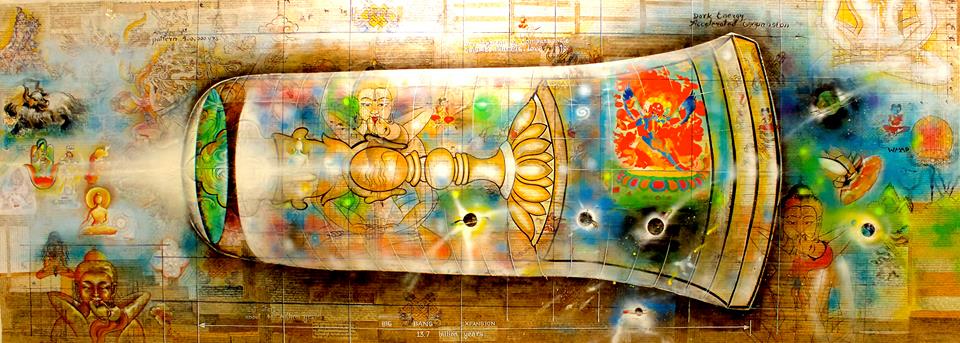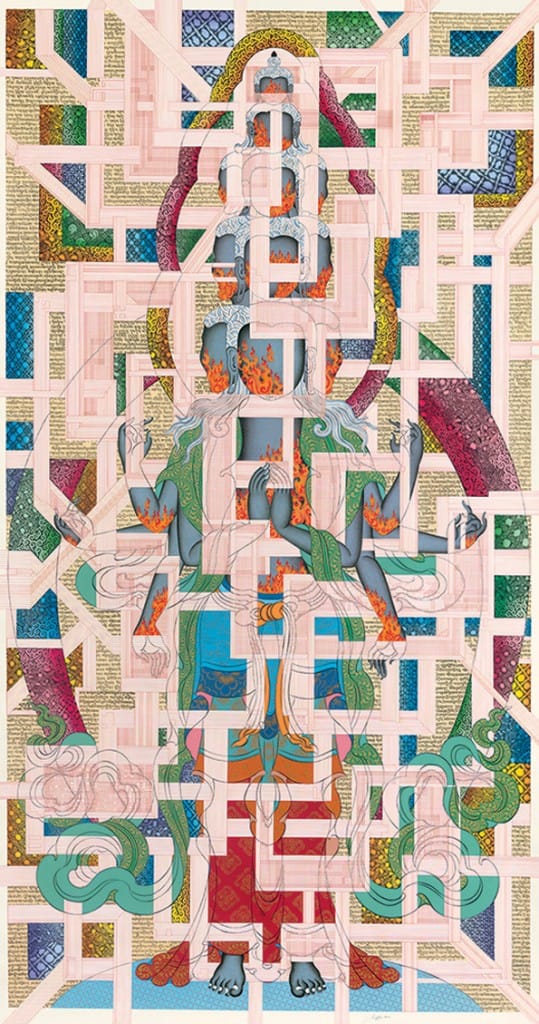March seems to be the month for art exhibits in which the artists re-imagine Buddhist imagery and concepts. Here’s a roundup of three shows opening across the U.S., and one abroad.
Tashi Norbu will be on hand at Tibet House NY for a reception Friday, March 14 (tonight!), to open his solo show, Transcending Boundaries, Reflecting Change. Norbu “juxtaposes the contemplative aesthetics of tangka painting and calligraphy with the energy of abstract expressionism and pop culture.” The show runs through May 9 and you can see an extensive slide show of the work on display here.
Artist Jim Stanford expresses his experience as an urban American Buddhist through kaleidoscopic photo manipulations of old Las Vegas streetscapes. His quest is to show the “infinite symmetry” of interdependence in a show called Indra’s Jewels, on display now through March 28 at Las Vegas’ Trifecta Gallery. See the full Las Vegas Weekly review here.
Honninmyo—the Japanese Buddhist concept of “true cause” found in the Lotus Sutra—both informs Sadako Lewis’s abstract paintings and is the title of two different exhibits in Mississippi. “Honninmyo is the motto of my life,” Lewis told the Biloxi Sun Herald. “Whenever I make a mistake, instead of taking time regretting or thinking, ‘What have I done?’ I start with a fresh determination.” One show’s on now through March 31 at the Mississippi Gulf Coast Community College in Gulfport and the next will open at Negrotto’s Gallery in Biloxi on April 3.
Another Tibetan artist, Gonkar Gyatso—whose piece Dissecting Buddha featured in a post here last month—in addition to currently exhibiting work alongside fellow Tibetan Tenzing Rigdol in Tibet and India: Buddhist Traditions and Transformations at The Metropolitan Museum of Art in New York (now through June 8), is just wrapping up a show entitled Meditation on Irony at SCAD’s Moot Gallery in Hong Kong.
Both artists “address Buddhist themes, but their intended audiences are global in scope, and their works are primarily vehicles of artistic expression and vision rather than objects of devotion,” writes The Met’s Assistant Curator in the Dep’t of Asian Art, Kurt Behrendt, in his essay, Tibetan Buddhist Art in the Twenty-First Century, just now online. “Nonetheless, merely presenting a Buddha or bodhisattva in a work of art charges it with a certain meaning, regardless of artistic intent.”
Or, as Behrendt quotes Gonkar Gyatso at the end, “When is the Buddha not the Buddha?”




